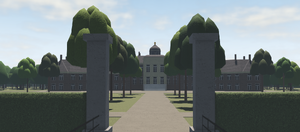The King's palace is a landmark based on the Dutch palace Huis ten Bosch.
| King's Palace | |
|---|---|
| Real life location | Den Haag |
| Game location | Hoogburg |
| Construction years | 1645-1652 and 1733-1737 |
| Function | Housing |
Lore
Medieval times left European royalty with a habit of living all over the place. This was impractical for kings, monarchs and other rulers of the Netherlands as they were rarely present at the grounds they owned.
This was until the early 17th century, when the wife of a Dutch prince decided she wanted a vacation home. As for the location, she wanted it near the coast, far enough to not be bothered by beach visitors. She wanted it near a town for convenience, but far enough away to not be bothered by the "common peasants". There were original demands, which scriptures only describe as "unnecessarily nitpicky and complicated hogwash". Eventually a large plot of land not too far away from Hoogburg was chosen as it fitted most of her requirements.
A small palace with an enormous garden was erected. The inside walls were painted by the best painters money could buy and the furniture was as luxurious as could be. The rights to this wondrous little construction were passed down generation by generation, with most royalty adding a bit of their own to it. Throughout the 17th and 18th century, the palace received Greek style pillars, houses for servants, a fountain, had the garden extended to include part of the nearby woods, received a moat and a bridge, a hedge and got expanded various times.
In the late 17th century, the French conquered Hoogburg in an attempt to start a new republic. The palace grounds were pledged to this republic and all of the furniture was taken out and sold to fund the further its creation. When the Netherlands became a monarchy in 1815, the palace fell back into royal hands and the new king, Willem I, swiftly moved in. Restorations took place and new furniture was acquired. By now, Hoogburg had cut down most of the surrounding forest, only the trees remaining standing on the other side of the moat. The king was especially fond of this forest and made special orders to preserve it. To be around the forest more, he chose this palace to be his main residence, using the other castles in the country during weekends and holidays. To this day, kings and queens still treat the King's Palace as such.
When Hoogburg got conquered again in the Second World War, the palace once more lost a lot of its furniture. The Axis took it, along with the pillars and parts of the fountain, to decorate their own houses. None of what was taken would be recovered.
Nowadays the king and queen reside in the castle, blasting loud music and partying for weeks on end for reasons they refuse to elaborate on.
Real life
Huis ten Bosch was build in the mid-17th century on the initiative of Amalia van Solms, wife of prince Frederik Hendrik van Oranje, who wanted a holiday home around Den Haag. Cost nor effort were saved in the build, using luxurious materials such as various types of marble. Sadly, Frederik Hendrik passed away before the building could be finished, in 1647. Amalia van Solms did use the palace until her death in 1675 and left the building to her daughters since all her sons had already passed away.
Out of the three remaining daughters, only one was living in the Republic of the United Netherlands but as she wasn't the oldest, she was given usufruct over the palace. Though, she never lived in it. Instead, she sold her usufruct to her cousin Willem III van Oranje. He moved in with his wife, Mary II of England. She hosted the first ball in the palace, to celebrate her husband's birthday (despite his absence).
By 1696, all but one of the three daughters remained, who had complete ownership of the building. 8 years later, Willem III passed away, granting her the usufruct too. She, however, didn't live in the Dutch republic. On top that, her mother, Amalia van Solms, had promised the palace to the children of her eldest daughter who had already passed away by then. Because her remaining daughter was not the oldest, Amalia van Solms gave all rights to the building to the oldest, still living child of the eldest sister: Frederik Willem van Pruisen. Through him, the rights to the building made their way to Willem IV, who expanded on it between 1733 and 1737.
During the French invasion, 1794-1814, the palace was confiscated as war loot and transferred to the Batavian Republic. It became national property and most furniture was sold. It wasn't until 1815, when the Netherlands became a monarchy, that the palace fell back into royal hands.
It received a lot of damage during the Second World War and received an extensive renovation in the early to mid 1950s.


